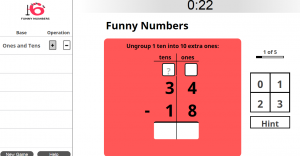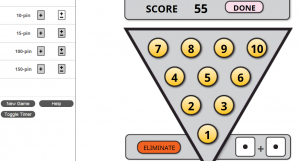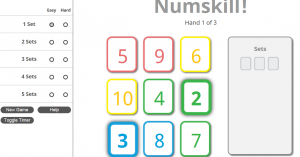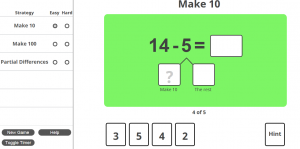Posted by kavery508 | Posted in Uncategorized | Posted on October 20, 2014
This week’s blog focus is all about math! As you can see from the family letter sent home, the focus of Chapter 3 is on subtraction of 3 digit numbers with and without regrouping. In order to get to that end point there are skills and concepts students will need to learn and understand.
As with addition, we want to move students away from counting back to get answers, since this only reinforces the most rudimentary of computational practices. The exception to this is -1 or -2, and even then we want students to immediately recognize what one or two less than a number equals because they are fluent with counting and number patterns, not because they are counting on fingers.
One such pattern is to use complements of 10 to help work with big numbers. If 10-7=3, then 60-7=53, and therefore 60-37 will result in some number with a 3 in the ones place (as it happens, 23). Similarly, use multiples of 10 when they appear: 80-20 is just two hops up on the number grid; so is 180-20, etc.
Another strategy is to Make Friendly Numbers. When subtracting 92-6, think: 92 is close to 90–just 2 more, so I’ll subtract 2 to make 90 because that’s easier to work with. Now I have 90-6. Using my complements of 10, I know that 10-6=4 so 90-6=84. Last, I have to remember that 2 I subtracted: since I subtracted 2 on one side of the equation, I need to do the opposite on the other side of the equals sign. Therefore I add 2 to 84, for a final answer of 86. It sounds lengthy, but the actual process goes quickly and it goes really quickly with practice. Here’s a more complicated one:
When subtracting 202-79, think: 202 is close to 200–just 2 more, so I’ll subtract 2 to make 200 because that’s easier to work with. Now I have 200-79: 79 is close to 80, just 1 less, so I’ll add 1. Now I have 200-80, which is easier: 120. Last, I had to minus 2 and plus 1 to get here: so on the ‘answer’ side of the equals sign, I will balance that by doing the opposite–plus 2, then minus 1. This gives me 120+2-1, or 121. Whatever you do to the numbers on one side of the equation, you do the opposite on the other.
We will also teach students how to use addition to check their answers in subtraction. I know that 58-17=41 because 41+17=58. Now is when the Greg Tang math games website (accessible from the Student Resources section of our blog above) comes in handy and gets interesting. Your child can practice this skill with the game Missing Numbers.
Finally, we will also teach kids to regroup, just as we did with addition. However, as before it’s vital that kids understand the numbers and meaning behind regrouping–that when we “cross out” or “borrow”, as most of us learned to do, that we are really trading in one of the tens for ten ones in order to make the ones place large enough to subtract with easily. As before, use the base ten blocks and/or the base ten mat to either model or draw subtraction homework problems. Greg Tang’s Funny Numbers can provide additional practice once the actual process of regrouping is understood.
In addition, both Math Limbo and Numskill can provide additional fun and challenging work with making 10.
Last, Break Apart is a really smart game where students can subtract by looking for 10s in the reverse of how they did it in the addition Making 10 Mental Math Strategy I discussed in September 29th’s blog entry.
It is not a goal that all students master the use of all of the above strategies. It is hoped that they will, through practice, strengthen their fluency with numbers using whatever strategies work for them, and that they will become ever flexible by understanding how to use others.







